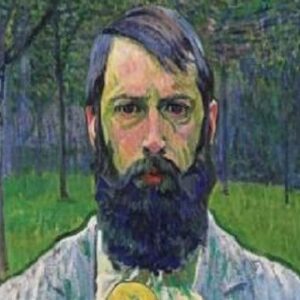Cuno Amiet was a significant modernist artist, painter, illustrator, graphic artist, and sculptor in the nineteenth century, and his name is well-known in the Swiss art world. Cuno Amiet was a modern art pioneer whose paintings were all about colors, colors, and more colors. Cunos’ art is heavily influenced by expressionism, as he was a member of the German expressionist group “Brucke.” The artist went on to create around 4000 paintings, including over 1000 portraits, painting landscapes with winter themes, fruits, and gardens. Cuno had a vibrant palette and a freestyle painting style. Cuno was an artist whose work was extraordinarily rich, flamboyant, and eye-catching, with a career spanning over 70 years and three centuries. Cuno was influenced by painters such as Ferdinand Hodler, yet he had his own sense of uniqueness and artistic flair. The following biography is a reflection of Amiet’s palette and the brilliance linked with it, as well as an extension of his life.
Childhood And Early Years
Cuno Amiet was born in the Swiss city of Solothurn in 1868. J.J. Amiet, his father, was a local historian and archivist. Cuno studied at the Kantonsschule Solothurn and earned a’matura’ there. Cuno continued his studies at the Academy of Fine Arts in Munich after completing an apprenticeship with Swiss painter Frank Buchser. From 1886 until 1888, he lived there.
Cuno met Giovanni Giacometti, his lifelong buddy, in the academy. Cuno and Giacometti moved to Paris in 1889 and obtained a position at the Académie Julian. Cuno was dissatisfied with his academy education and transferred to Pont Aven, a fishing community in Brittany, in 1892.
Career of Cuno Amiet
For 13 months, he lived in Breton, a well-known village. Cuno was taken aback by his contact with the painters and the work produced by the Ganguin group. Cuno grew as a colorist as a result of the inspiration he received from the artists there and their work, and he learned a lot from Emile Bernard, Paul Sérusier, Roderic O’Conor, and Armand Séguin. The art of etching was introduced to him by Armand Séguin, who ingrained it in him.
In 1893, Amiet returned to Switzerland because he couldn’t afford to pay his bills. In the village of Hellsau, he established his own studio. Cuno was drawn to Ferdinand Hodler since his paintings were not well received and respected. He was an artist who had to deal with the criticism of others. Cuno accessed the vivid textures adopted from Port-Aven and Hodler’s strict German designs under Hodler’s influence.
Cuno was condemned as a clone of Hodler during the Vienna Secession exhibits. Cuno moved to the French style of art he had learned from Pont-Aven after discovering this truth, and he quickly established a place for his unique style. Cuno’s best paintings were done during this time period, from 1904 to 1914.
Cuno’s first solo exhibition was held at the Künstlerhaus in Zurich in 1905. Despite the work’s widespread criticism and controversy, E. L. Kirchner, E. Heckel, and K. Schmidt-Rottluff, future members of the German Expressionist group Bridge or Brücke, took notice of Cuno’s work. Amiet was invited to participate in the Bridge show after a few weeks, when it was properly formed. The show in December 1906 included his work. Cuno was a member of the group until 1913, when it was disbanded. By presenting “Brücke,” or Bridge, as a group in Solothurn, Amiet helped to portray a modernist culture in Switzerland.
Cuno moved to Oschwand after his marriage in 1898. Wilhelm Worringer, Arthur Weese, Samuel Singer, Adolf Frey, and Hermann Hesse were among the numerous notable artists, writers, painters, and scholars who visited his villa in Oschwand. In his Oschwand residence, he also taught a large number of students. Cuno got several orders, both official and private, beginning in 1910. The art museum in Zurich’s veranda, Bern’s gymnasium frescoes, and the art museum’s wall decorations were among the most notable.
Cuno remained alone in his picturesque settlement of Oschwand by 1912. The reason for this was that he was traveling to Dresden, Munich, Cologne, Jena (with August Macke), Berlin, Frankfort, Hamburg, and Amsterdam for exhibitions. He received an honorary doctorate from the University of Bern in 1919.
Cuno excelled at oil painting, but he also excelled at watercolor painting and printmaking. Cuno tried his hand at sculpting in the early 1920s, creating a few portraits out of bronze and marble. He created a number of wall paintings in the 1920s and 1930s. A fire at the Münchner Glaspalast (crystal palace) in 1931, however, destroyed 50 of his most famous sculptures. Cuno’s work throughout the 1940s and 1950s focused more on abstract notions centered on space and light. His brilliance was shown by the specks of color and the use of pastels.
Personal Life And Death
In 1898, Amiet married Anna Luder von Hellsau. The marriage was witnessed by her sister and Cuno’s friend, Giacometti. Lydia Thalmann, the couple’s adoptive daughter, was the couple’s only child. He went dead in Oschwand on June 6, 1961, after a protracted illness. Positions And Awards 1911–15 and 1931–32, he served on the Swiss Federal Art Commission. From 1934 to 1948, he was a member of the Gottfried Keller Foundation’s board of directors. From 1935 to 1948, he was a member of the Kunstmuseum Bern. In 1919, he received an honorary doctorate from the University of Berne.
Estimated Net Worth
The estimated net worth of Cuno Amiet is not available.


